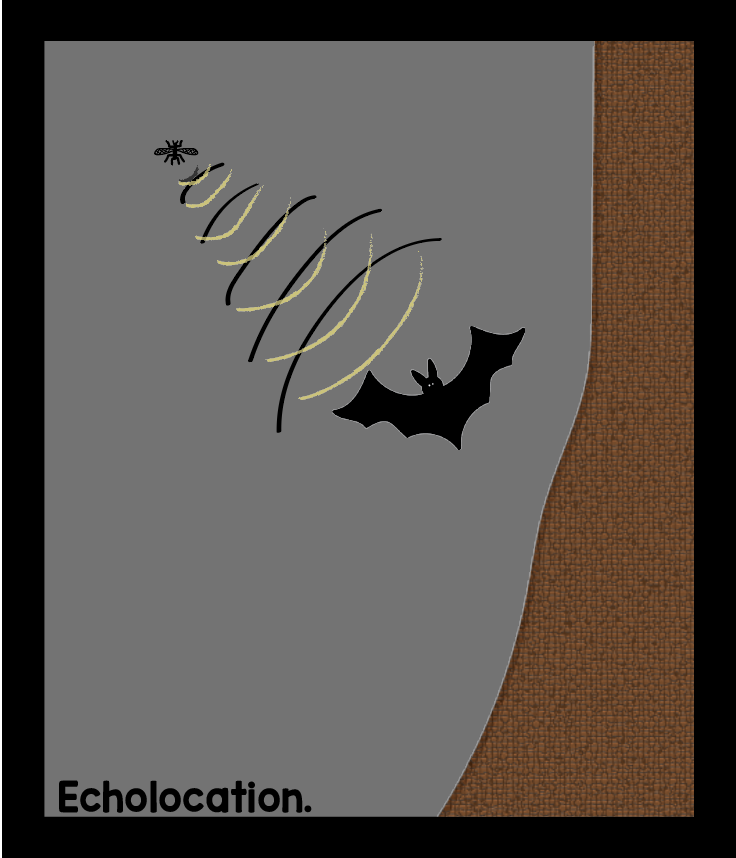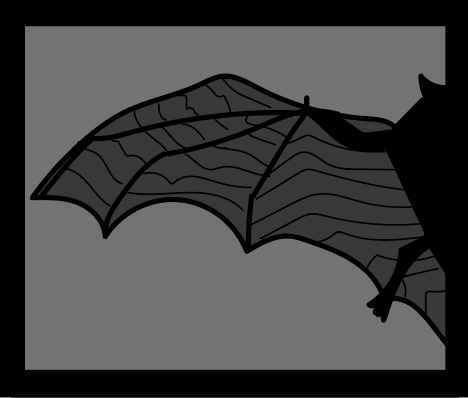Bat Senses
Bats are amazing creatures and we hope you gain a sense of appreciation for these creatures through your 5 senses!
SEE:
Have you ever heard the expression, “You’re blind as a bat” ?
Next time you hear someone use this expression, please feel free to correct them! Bats are NOT blind!
There are 2 main bat groups- Megabats and Microbats!
Megabats look like more typical mammals and are sometimes called ‘flying foxes’ because of this. Megabats eat fruit and only live in tropical areas. Megabats are larger bats with big eyes and great vision for flying and hunting for food. Most Megabats do not use echolocation.
Microbats eat insects, fish, lizards, birds, nectar and blood! Microbats live all around the globe (except in arctic areas!) and make up most of the bat population in the world. Microbats are small bats with smaller bodies and eyes, but bigger ears! Even with small eyes these bats can still see! Microbats don’t rely on their eyesight, but instead use echolocation!
Therefore, no bats are blind - but some bats rely on their eyes more than others!
HEAR:
The Power of Echolocation
What? A navigation tool using reflective sounds.
Who? Bats and dolphins use echolocation.
How? Bats make sounds (the sound waves are at such a high frequency no humans can hear it!) and wait for the sound waves to bounce off (or echo) back to their ears. For example if a bat is flying and makes a sound and no sound waves bounce back to the bat’s ears that means it is safe for the bat to fly forward! Bats know the distance of objects from their body by the speed the sound wave bounces back.
Why? Bats use echolocation to navigate and find food.
Touch:
Bats have a strong sense of touch too! They have touch- sensitive receptors on their wings to detect and move appropriately in response to the motion of air over their wings. Bat wings are thin and flexible and the bat’s fingers and thumb are attached through webbing. This structuring helps the bat stay aerodynamic and easily reshape its wings in flight, using tiny muscles to readjust. Bats are amazing!
Bat Obstacle Course for Kids!
using Sight, Hearing, and Touch
Create a simple obstacle course by placing pillows and other soft objects around a space. (Choose objects you can easily move around in between rounds-& be sure to change around the obstacles between rounds so children can’t simply memorize the course!)
Have children first navigate through the space using only their eye sight! (This should be easy)
Next have the children navigate through the space using only their sense of touch, so children should be blindfolded or choose to simply close their eyes. (This will be slightly challenging)
Finally have the children navigate a space using only their hearing, like bats use echolocation. So have the child use a blindfold or just close their eyes and encourage them not to use their hands or body to feel the obstacles, but instead click their tongue to try to hear the obstacle! To inspire children share about Ben Underwood, a boy who used echolocation after going blind at age 3. (This should be the most difficult and the child will likely fail, but that’s okay, it will be a memorable experience for them to forever remember what echolocation is!)
Smell:
Your nose knows!
In the book Stellaluna by Janell Cannon, Stellaluna is a fruit bat and therefore doesn’t rely on echolocation but uses her keen sense of smell & her sight to safely navigate in the darkness and also find the delicious fruits she likes to eat. Near the end of the book when she encounters her mother, her mother sniffs her fur and says,
"You are Stellaluna. You are my baby". She is able to identify her by scent. In this fun activity, Where's my family? you will get to test out your own sense of smell.
What you need:
1 cotton ball per participant (adults & children)
2 different scents (perfume, vinegar, peppermint, essential oil drops)
a group of participants
What you do:
Ahead of time: make two small bags of cotton balls and drop a scent onto the cotton balls in each bag. For example, if you have orange oil as one scent and peppermint as the other, one bag will have all orange scented and one will have all peppermint. Select two leaders who will have different scents.
To play:
Randomly give the participants each a cotton ball. The leaders place their cotton ball in an open palm so the others can smell it. Participants smell both leaders to determine which family they belong to. Participants can smell others in the group as well once the game gets underway. Play outside so there is plenty of space to move and have the participants fly from one leader to another. Like-scented bats stick together in a family. Get creative and wear bat wings to play or make bat caves for the bat families to fly to afterwards. It is also fun to call out "Daylight!" during the game and everyone has to stop where they are and put their feet up in the air.
Taste:
Did you know that bats are pollinators? Just like butterflies, bees and hummingbirds, bats pollinate too-except they do it at night! There are more than 300 types of fruit and plants that rely on bats for pollination. Bats are attracted to flowers that open at night, are large in size, white or pale in color and very fragrant. Nectar-feeding bats visit flowers to drink nectar and in the process drop pollen to other plants. Just another reason that bats are totally cool and need our protection.
You can make a fruit salad with ingredients that a bat helped produce!
Bat Fruit Salad!
What you'll need:
An adult to help with cutting tasks - Cutting board - Knives (have some kid friendly ones available) - Bowl - Spoon
Ingredients: All thanks to bats!
bananas & mangos
Have an adult cut the mango into two halves. Children can cut the mangos into chunks and remove the skin from the chunks.
Peel the banana and have the children cut them up into chunks. Mix the mango & banana chunks in a bowl and enjoy a tasty snack. Be sure to thank a bat!
How to help a bat
Be a bat activist and help the bat population near your home or school.
What can you do?
Build/purchase a bat house
2. Leave dead trees for bats to use as habitats
3. Have a water source available -your bird bath will work fine
4. Take a walk at dusk & appreciate the beauty and worth of this amazing nocturnal creature
5. Tell others about all the cool things you learned about bats
More information on bat conservation can be found at https://www.batcon.org/
Visit https://www.batcon.org/ to find out how you can help in the conservation efforts to help bats.







